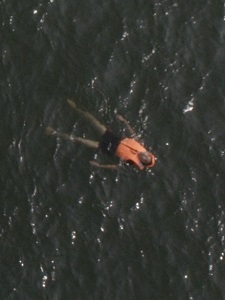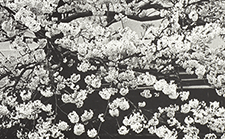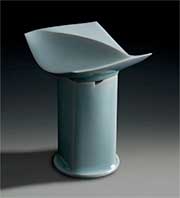
Past Exhibitions
[ Perspectives Series | Other Past Exhibitions ]
Notes From The Desert: Photographs By Gauri Gill
September 17, 2016–February 12, 2017
Since the late 1990s, Gauri Gill (born 1970) has been photographing marginalized communities in western Rajasthan, India. Often revisiting her extensive archive of negatives, collectively titled Notes from the Desert, Gill selects images and arranges them into different series focusing on a particular individual or idea. This exhibition showcases nearly sixty of her prints, including three powerful portraits from Balika Mela, named for a village fair for girls.

Symbolic Cities: The Work of Ahmed Mater
March 19–September 18, 2016
Born in 1979 in southern Saudi Arabia and trained as a medical doctor, Ahmed Mater has been a practicing artist since the early 1990s, creating works that offer an unparalleled perspective on contemporary Saudi Arabia. Now based in Jeddah, Mater has focused primarily on photography and video since 2010. From abandoned desert cities to the extraordinary transformation of Mecca, Symbolic Cities presents his visual and aural journeys observing economic and urban change in Saudi Arabia. The exhibition, the first in the United States solely dedicated to Mater, also debuts new works based on his extensive research on Riyadh’s development.

Lost World: Video Art by Charles Lim and Gideon Mendel
May 24–July 6, 2014
Sackler, International Gallery
Lost World features video works by Charles Lim and Gideon Mendel. Both artists examine the dramatic consequences of major shifts in the world’s primary natural resource—water. Lim has been exploring the transformation of maritime resources in his native Singapore through his ongoing Sea States project. Since 2007, Mendel has been visiting flooded communities throughout the world to create Drowning World, a series of powerful still and moving portraits of flood victims. Held in conjunction with Perspectives: Rina Banerjee.
For more information and related programming, visit asia.si.edu and the Smithsonian’s Waterways project.

Sense of Place: Landscape Photographs from Asia
August 3–November 11, 2013
Sackler
Asian landscapes are an enduring and multifaceted subject of photography throughout the medium's history. Many examples of this genre can be found among the thousands of photographic materials held in the Freer|Sackler Archives and collections. This exhibition highlights the Sackler's growing collection of modern and contemporary photography with a selection of works from Iran, China, Japan, and Vietnam acquired since the late 1990s. Prints by Abbas Kiarostami, Lois Conner, Moriyama Daido, Seifollah Samadian, Hai Bo, and An-My Lê employ views of the landscape to convey personal and cultural contexts of meaning.

Nine Deaths, Two Births: Xu Bing's Phoenix Project
April 27–September 2, 2013
Chinese artist Xu Bing spent more than two years creating his newest work, Phoenix Project, a massive installation on view at the Massachusetts Museum of Contemporary Art (MASS MoCA). At once strange and fiercely beautiful, the installation comprises two birds fabricated entirely from materials found at construction sites in Beijing. This complementary exhibition at the Sackler traces the evolution of Phoenix Project.

Reinventing the Wheel: Japanese Ceramics 1930–2000
July 2011–July 2013
Modern and contemporary Japanese ceramics were among the first of many new directions in collecting made possible by the opening of the Sackler Gallery in 1987. Today, the Sackler collection represents significant trends in Japanese ceramics since the 1930s, when traditional workshop masters took on new roles as studio potters alongside artists in other media. Potters at regional kilns revived ancient firing and glazing technology for use in expressive new vessel forms. In postwar Kyoto, ceramic artists departed from conventional ideas of function to create sculptural forms. Today’s potters sample at will from these trends, blending meticulous skill with daring reinterpretations of shapes and materials. This installation of highlights spans legendary Living National Treasures to young virtuosos of the present day.

Shadow Sites: Recent Work by Jananne Al-Ani
August 25, 2012–February 10, 2013
Inspired by both archival photographs and contemporary news reports, Jananne Al-Ani has created a new body of work that explores enduring representations of the Middle Eastern landscape. Shadow Sites II (2011) and two earlier video works are exhibited alongside a selection of extraordinary original prints by renowned archaeologist Ernst Herzfeld (1879–1948). Separated by nearly a century, these works pose fascinating questions about the impact of photography on views of the Middle East. This exhibition is a highlight of the Sackler Gallery’s 25th anniversary celebration in 2012.
Fiona Tan: Rise and Fall
September 25, 2010–January 16, 2011
Fiona Tan, who was born in Indonesia in 1966 and now lives in Amsterdam, explores individual and collective identity in a world increasingly shaped by global culture. Embedded in her films and videos is a fascination with the deceptive nature of representation and the play of memory across time and space. This exhibition brought together for the first time several of Tan’s video works with a selection of related drawings and photographs. As a group they offered insight into the development of her approach to the medium of the moving image. Rise and Fall was the first major presentation of Tan’s work in the United States and was organized by the Vancouver Art Gallery and Aargauer Kunsthaus.
Moving Perspectives: Yeondoo Jung
November 21, 2009–March 14, 2010
Through photography and video, Yeondoo Jung (born Jinju, Korea, 1969) invites viewers into the dreams and memories of others. This exhibition presented two video works, including a multi-screen installation, in which anonymous strangers are filmed as they recall moments in their lives. While they share their stories of past loves, youthful ambitions, hardship, and lifelong secrets, a team of stagehands reconstructs the settings for these memories. Jung emphasizes the artifice of each scene by orchestrating clever set recreations and filming the process from beginning to end, or by manipulating camera angles and lighting effects in long outdoor sequences. Ultimately, these videos suggest that, when filtered through nostalgia and the passage of time, reality exists somewhere between truth and imagination.
Moving Perspectives: Shahzia Sikander/Sun Xun
July 18–November 8, 2009
Trained in Pakistan and in the United States, Shahzia Sikander (born 1969, Lahore, Pakistan) deftly reinterprets miniature painting by isolating and abstracting formal compositional elements often found in this densely layered and intricate art form. The dynamism of her paintings is set in motion in her video works, where the repetition of abstract forms becomes a buzzing hive, calligraphy whirls in and out of view, and imaginary curves morph into vivid landscapes. Similarly, Sun Xun (born 1980, Fuxin, China) creates hundreds of paintings and drawings by using old newspapers or entire blank walls. Filming his hand-drawn images, he transforms clocks, magicians, words, and insects into animated symbols that flicker across the screen in dark allegories on the nature of historical consciousness and the passage of time.
Moving Perspectives: Jun Nguyen-Hatsushiba/Fiona Tan
March 14–July 5, 2009
The lush landscape of Laos is the setting for a series of performances by art students from Luang Prabang in The Ground, the Root, and the Air: The Passing of the Bodhi Tree (2007), a single-channel video by Jun Nguyen-Hatsushiba. The work culminates in a dramatic moment that captures the younger generation’s struggle to reconcile a rich cultural and religious heritage with the rapid currents of global economic and social change. The endurance of ritual in contemporary society is a starting point in Fiona Tan’s stunning video installation Saint Sebastian. With careful attention to images and sound, Tan transports the viewer into a sensual experience of a centuries-old Japanese tradition that marks a woman’s coming-of-age. In so doing, she comments on the history of moving image and the role of the visual in shaping perceptions of “exotic” cultures.
Moving Perspectives: Lida Abdul/Dinh Q Lé
December 6, 2008–March 1, 2009
Lida Abdul from Kabul, Afghanistan, and Dinh Q Lé from Ha-Tien, Vietnam, use video to explore the shifting memory of trauma and the inevitable resilience of life. Drawing on recent histories of conflict and destruction, both artists returned to their native countries to explore societies in transition. After years of living in India and the West, Abdul returned to Kabul in 2001, where she created a series of short performance-based videos staged among the ruins of her homeland. Similarly, Dinh Q Lé returned to Vietnam to examine the war within the context of contemporary Vietnamese society. For Lé, who grew up in the United States, the Vietnam War is an amalgamation of distant childhood memories, documentary materials, and Hollywood films. In The Farmers and the Helicopters (2006), Lé juxtaposes contemporary interviews and images of the rural landscape with film footage to reveal more complex narratives surrounding memory in a changing postwar Vietnam.
Moving Perspectives: Yang Fudong, Cao Fei, and Ou Ning
September 6–November 30, 2008
Internationally renowned artist Yang Fudong expands upon Chinese painting and folklore to create dreamlike environments permeated with a sense of dislocation and loss. In Liu Lan (2003), a young man in a modern suit and a traditionally dressed woman meet while a female voice sings a plaintive folksong about separated lovers, creating an eloquent metaphor for the distance between the past and the pursuit of an uncertain future. This lyrical approach vividly contrasts with San Yuan Li (2003) by Cao Fei and Ou Ning. Its fast-paced montage, sharp camera angles, and pulsating sound underscore the rapid change, architectural density, and constant activity that are overtaking China’s urban landscape.
Hiroshi Sugimoto: History of History
April 1–July 30, 2006
Comprising more than 80 works, History of History juxtaposed Sugimoto’s own photographs—selected from the artist’s well-known series of seascapes, natural history dioramas, and wax museum figures—with an enormous range of geological specimens and traditional Japanese and ritual artifacts drawn from his private collection. His preoccupation with the passage of time and spirituality took on concrete, multiple forms as he placed his photographs in the contexts of the history of Japanese art, civilization, and ritual.
Kenro Izu: Sacred Sites Along the Silk Road
June 9, 2002–January 5, 2003
Japanese-born New York photographer Kenro Izu is best known for his photographs of the ancient Buddhist temples at Angkor, Cambodia; his still-life images of decaying flowers; and his sensuous nudes. This exhibition of large-format platinum prints focused on monasteries, royal tombs, ancient cities, and small personal shrines set amid the immense grandeur of the Himalayas or vast and desolate deserts in western China, Ladakh, and Tibet. Emphasizing both beauty and decay, these photographs serve as commentaries on the passage of time marked in a range of Buddhist achievements and expressions that spread across the Asian landscape.
Word Play: Contemporary Art by Xu Bing
October 21, 2001–May 12, 2002
A leader in the avant-garde movement that emerged in China between the end of the Cultural Revolution and the Tiananmen Square massacre, Xu Bing is recognized as one of the most important Chinese artists of the last 30 years. This was the first major exhibition of his work since 1991. It included A Book from the Sky (Tianshu), books and scrolls printed using two thousand unreadable imitation “Chinese characters” invented by the artist to express humankind’s struggle with communication. Other works on view—Square Word Calligraphy; The New English Calligraphy; and A,B,C—large landscripts (calligraphic landscapes), and a classroom demystified the art of calligraphy and addressed issues of communication.
Auto-focus: Raghubir Singh’s Way Into India
March 8–August 10, 2003
Raghubir Singh, celebrated for his visual essays on India and his role as a pioneer of color photography, drew inspiration from the work of the French photographer Henri Cartier-Bresson and captured decisive moments that reveal the distinctive palette of India. In A Way into India, Singh focused on the Ambassador car in which he traveled as he documented the Indian landscape over a 30-year period. This exhibition featured 48 of these vibrant photographs that express “a life which is endowed with every shade of color from the peacock’s plume to the black of the elephant to the weathered landscape of the farmer’s face.”
Devi by Ravinder Reddy
November 4–March 17, 2002
By layering elements of traditional Hindu imagery and contemporary popular culture and using modern materials and traditional sculptural methods, Ravinder Reddy transforms an ordinary woman into a monumental, richly colored sculpture of the great goddess. On view in the Sackler pavilion, visitors were greeted by Devi, one of Reddy’s iconic heads with large, lotus-shaped eyes that recall images of Hindu deities and brightly colored South Indian temple gateways. His subjects are females of various classes—prostitutes, bonded laborers, untouchables, and women from tribal communities—whose images have been made precious through the use of gold and enlarged scale.
Constructing Identities: Recent Work by Jananne al-Ani
November 21, 1999–February 28, 2000
Using photography, Jananne Al-Ani explores the popularized image of the Near Eastern woman as a point of departure for examining identity across generations and cultures. Two pairs of large-format photographs, five pairs of transparencies, and a slideshow greeted visitors to the Gallery’s first presentation of contemporary works by an artist from the Islamic world. Addressing a topical issue—Orientalism, and in particular the Orientalist representation of women—the images seek to examine and deconstruct the stereotypes based on the “mystery and exoticism” that Westerners commonly associate with the veiled women of west Asia.
